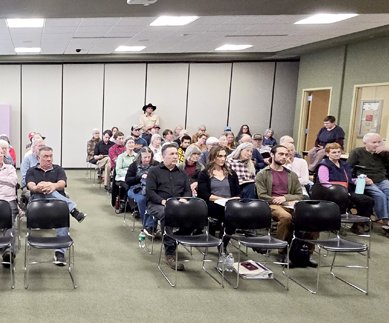Almost 30 citizens attended an inaugural meeting in Richland Center to discuss formation of producer-led watershed councils in Richland County. The county is surrounded by strong enclaves of producer-led watershed efforts in Sauk, Iowa and Vernon counties.
Three producers – two from Vernon and one from Sauk County – participated in a farmer panel to share their experiences of watershed councils. Those three producers were Roger Bindl of the Sauk Soil & Water Improvement Group (SSWIG), and Bradley Robson and Kent McClurg of the Bad Axe Watershed Stewards.
Major organizers of the event included Brian McGraw, Chair of the Town of Eagle and member of the statewide Land + Water Board; Anastasia Kurth, UW-Extension Regional Crops and Soils Educator for Sauk, Juneau and Richland counties; and Ellen Tyler with Southwest Regional Planning Commission (SWRPC).
Also attending the meeting were Richland County Conservation Director Cathy Cooper, Wrangler Jones with DATCP, Mark Cupp – Executive Director of the Lower Wisconsin State Riverway Board, and representatives from USDA-NRCS.
“I am from a multi-generation Richland County family, have served as chair of the state Land+Water Board for 25 years, and as Executive Director of the Lower Wisconsin State Riverway Board for 35 years,” Cupp said. “I am here because anything that helps to protect water quality in the Lower Wisconsin River is something that interests me.”
DATCP program
Wrangler Jones, DATCP Conservation Agronomist started the meeting with an overview of the agency’s Producer-Led Watershed Protection grant program.
“The Producer-Led program is intended to support farmer-driven, local efforts to protect watersheds,” Jones explained. “If you have five farmers in a watershed that step forward, then your group can qualify for grant funding. In the 2025 grant cycle, there will be a total $1.25 million in grant funding available. Each group will need to work with an entity that can receive the grant funding for them, which we refer to as a collaborator – that can be a county land conservation department or a non-profit.”
Jones said that applications for the grant funding will be due on September 13, the awards will be announced in November, and the funds would begin to be available on January 1, 2026.
“This program has really grown in popularity from its beginning in 2016, with 14 awards for a total of $242,550,” Jones explained. “In 2025, DATCP received 49 applications, made 49 awards, and distributed a total of $1,000,000.”
Farmer panel
Each of the farmers on the panel were asked to share a bit about their experience in working with a Producer-Led Watershed Council.
The Sauk Soil & Water Improvement Group’s Roger Bindl kicked things off, sharing that he has found the funding allocated to putting conservation practices on the land particularly helpful.
“When our group allocates these funds to our members, it is really intended to get a producer started with trying something new,” Bindl explained. “The idea is that once you give it a try, and start to see the benefits of it, then you will keep doing it on your own.”
Bindl said that he attends a lot of meetings, and that “if I can get just one person to try cover crops or some other practice, then all the time I’ve spent will be worth it.”
Bindl told the group that he had just received the Conservation Farmer of the Year recognition from the state Land + Water Board.
Kent McClurg of the Bad Axe Watershed Stewards (the Bad Axe River Watershed in Vernon County) was up next.
“I just got back into farming with my dad three years ago, and we run 400 acres where we raise crops and a herd of 80 beef cattle,” McClurg said. “We have been planting cover crops on the farm for the last 10 years, starting with rye and then expanding to other small grains, and we have really seen the benefits of cover crops.
“Planting cover crops is what I would do, even if I didn’t receive an incentive payment,” McClurg said.
Brad Robson, who farms with his dad in the Hornby Hollow subwatershed of the Bad Axe River Watershed, wears a lot of hats. At one time or another, Robson has been seen attending meetings of just about all the watershed councils in Vernon County, including the Tainter Creek Watershed Council, the Rush Creek Watershed Stewards, and the Coon Creek Community Watershed Council.
Robson’s daytime job is as Conservation Agronomist with the Monroe County Land Conservation Department, where he has been instrumental in helping a watershed council to form in the flood-ravaged Little La Crosse River Watershed.
“On our farm, we run 300 acres, with 160 acres in crops, 85 acres in pasture, and the rest in woods,” Robson said. “We pasture a herd of 40 beef cattle, and plant a diversified rotation of crops.”
Robson said he likes being involved with producer-led groups because it provides a chance for farmers to talk to one another and to learn from each other.
“All told, with the producer-led groups active now in Vernon, Crawford and Monroe counties, I calculate that we have between 400,000 to 500,000 contiguous acres that are being protected by watershed councils,” Robson shared. “We’re all in this together, and there’s things we can get along on – and we need to do so.”
Question/answer
Richland County Farm Bureau president Josh Joseph asked the farmers on the panel about whether there is any talk among watershed councils about reducing the use of agricultural chemicals, because using a no-till production method requires a lot of spray.
“Personally, I want to farm as organically as I can conventionally,” Robson responded. “One of the practices incentivized by our watershed group is use of the roller crimper method to plant a crop into a living cover crop.”
Kent McClurg said that he’s found that use of cover crops can really help to reduce the amount of chemicals he needs to apply.
“The ground wants to be covered, so my method is to control what that cover will be,” McClurg explained. “I’ve also planted green directly into a living cover crop without using any spray.”
Bindl pointed out that cover crops shade out the weeds, and they help to cycle the nutrients.
“The best corn crop follows a legume, so I always plant a legume crop before corn,” Bindl said. “I always say that if you’re doing something that doesn’t make you feel uncomfortable, you’re not trying hard enough.”
Another participant asked the farmers to describe what meetings of their watershed councils are like.
“At the end of every meeting, we collaborate on what the agenda for the next meeting will be,” Bindl said. “We always meet from 5 to 7:30 p.m. in Rock Springs, and we have a Zoom link, which allows more people to participate, than if we didn’t offer it.”
Bindl said that every year, SSWIG holds their annual meeting in Baraboo in February. He said that his group has found collaboration with other groups in the area very helpful to be able to afford to bring speakers in, because he says that some of the speaker fees for the really knowledgeable people can be fairly expensive.
“The Bad Axe Watershed Stewards meets monthly, and we start at the beginning of the year to identify topics of interest to the group,” McClurg explained. “Usually, our decisions are made with a kind of consensus, and we start with a meal at 6:30 p.m., and then start our meeting at 7 p.m.”
McClurg said that he had recently made a presentation about what he’d learned using soil tests on his land with producers in his group, as well as with members of other nearby groups that belong to the Hill Country Watershed Alliance.
“Our groups are for helping each other to learn,” McClurg said.
Robson said that with all the meetings of all the different groups he’s attended over the years, he’s seen multiple ways for leadership roles in the groups to evolve. For instance, he said the Bad Axe and Coon Creek groups have boards.
“All year long, the boards listen to what the members of the group are interested in, and then they use that information to submit the DATCP grant application,” Robson explained. “Most groups have a president or a chair, and most of the decisions are made by consensus – it really comes down to how you and your collaborator want to manage it.”
Ellen Tyler with Southwest Regional Planning Commission asked the farmers why they do what they do, even if they aren’t incentivized for it?
Bindl responded that when he pursues soil health, then he doesn’t have to see his soil eroding, and he knows that he is helping to prevent flooding.
“When you build soil health, you build the capacity of the soil to infiltrate water, which can help to reduce flooding and erosion,” Robson responded. “We have to figure this out for the long-term, even without knowing if we’ll see a return on our investment.”
McClurg pointed out that when trying something new on your farm, it requires a commitment of at least 3-5 years before you really start to see the benefits.
“We need to show that we as farmers are good stewards of the land,” Robson responded.
Another participant asked the farmers on the panel about why their groups started?
Robson said that with the Coon Creek group the catalyst was the 2018 flood, where 14 inches of rain fell overnight in a small area, and five flood control dams were breached.
“The Bad Axe group got its start when Kevin Parr was named Conservation Farmer of the Year by state Land + Water,” Robson said. “After the ceremony on the farm, a group of farmers got together in the barn, drank a few beers, and talked about the need to do more to protect the Bad Axe River Watershed.”
The last question was what are the biggest hurdles or barriers you see to producers adopting practices?
“I think finances is a big issue,” McClurg said. “It can be hard to see the ROI of putting a practice on the land, and you have to stick with it. The top two inches of soil is the most valuable part of a farm.”
Robson says he thinks there are social aspects that can make trying something new or different difficult for producers.
“Whether it’s a family tradition, or you’re worried about what the neighbors will think – safe to say, everyone has a reason for the things they do – so it’s just a matter of you finding your reason,” Robson said.





